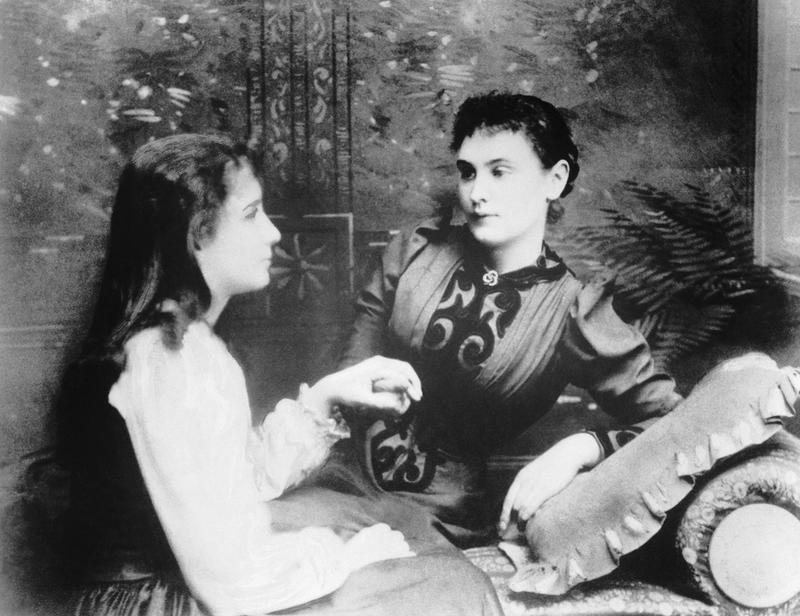
Imagine the loneliness and isolation of a person who is both deaf and blind. Even worse, imagine that isolation beginning when you were only 19 months old when the disease took these vital senses away before you comprehended the concept of what the word was, leaving you with limited means to convey your thought and feelings. This is the description of the challenge that newly graduated teacher Anne Sullivan was taking on when she was hired to be the governess and teacher to seven-year-old Hellen Keller. Anne was only twenty years old and was herself seriously visually impaired.
Sullivan was born on 14 April 1866 in Feeding Hills, Agawam, Massachusetts; the oldest child of Thomas and Alice Sullivan, who emigrated to the United States from Ireland during the Great Hunger. The family lived in extreme poverty. When she was five years old, Sullivan contracted the bacterial eye disease trachoma, a painful infection that left her nearly blind. When she was eight, her mother died from tuberculosis, and two years later, her father gave up his children as he could not raise them on his own.
Anne and her brother, Jimmie, were sent to the almshouse in Tewksbury, Massachusetts. Underfunded and overcrowded, the Tewksbury Almshouse housed an average of 940 men, women, and children during the years that Sullivan was there. Among its residents were those suffering severe mental illness. With primitive medical care, the mortality rate was very high; within three months of their arrival, Jimmie died, leaving Anne alone in what could only be described as an earthly hell.
Eventually, word of the horrific conditions at Tewksbury became public knowledge, prompting the state board of charities to investigate. The now teenaged Anne had heard that there were schools that specialized in educating the visually impaired. When a group of inspectors came to the almshouse in 1880, Anne followed them around until finally flinging herself on one of the officials, Frank B. Sanborn, pleading, “Mr. Sanborn, Mr. Sanborn, I want to go to school!”
Anne was transferred to the Perkins School for the Blind on 7 October 1880. Anne was woefully behind in her education, and the rough manners required to survive in the almshouse made it difficult for her to fit in amongst a student body that was mainly composed of children of the affluent. Yet, she soon closed the gap with her classmates with iron-willed determination. Sullivan underwent a series of eye operations that significantly improved her vision. In June 1886, she graduated as the valedictorian of her class. In her valedictorian address, she stated:
“Duty bids us go forth into active life. Let us go cheerfully, hopefully, and earnestly, and set ourselves to find our especial [sic] part. When we have found it, willingly and faithfully perform it; for every obstacle we overcome, every success we achieve tends to bring man closer to God and make life more as He would have it.”
Sullivan arrived at Helen Keller’s house on March 5, 1887. Sullivan immediately began to teach Helen to communicate by spelling words into her hand, starting with “d-o-l-l” for the doll that she had brought Keller as a present. At first, the work was slow and frustrating; Keller had no understanding of connecting objects and words.

However, after a month of Sullivan’s constant and patient efforts, there was a breakthrough. As Sullivan spelled the word water in one hand while running cool water over the other, Helen Keller made the connection that the gestures symbolized “water.”
Sullivan’s breakthrough in communicating with Keller came the next month when Helen realized that the motions her teacher was making on the palm of her hand while running cool water over her other hand symbolized the idea of “water.” Keller later recalled, “I stood still, my whole attention fixed upon the motions of her fingers. Suddenly I felt a misty consciousness as of something forgotten — a thrill of returning thought; and somehow the mystery of language was revealed to me. I knew then that w-a-t-e-r meant the wonderful cool something that was flowing over my hand. The living word awakened my soul, gave it light, hope, set it free!.” Having released the genie of language out of the bottle, Keller nearly exhausted Sullivan with her zeal to learn the names of the other objects in her world. Within six months under Anne Sullivan’s guidance, Keller learned 575 words and the “multiplication tables as high as five and the Braille system.”
Anne Sullivan would be Helen Keller’s companion for the rest of Anne’s life. She would travel with Hellen to study at the Perkins School for the Blind and later the Horace Mann School for the Deaf. She accompanied Helen to Radcliff, where Keller graduated as a member of Phi Beta Kappa, becoming the first deaf-blind person to earn a Bachelor of Arts degree.
Anne Sullivan would remain a constant companion to Helen Keller until her death on October 20, 1936, with Helen holding her hand. Sullivan was interred at the National Cathedral in Washington, D.C, the first woman to be recognized for her achievements in this way. When Keller died in 1968, she was cremated, and her ashes were interred alongside those of Sullivan.
It was no less a person than Mark Twain who described Anne Sullivan as ‘a Miracle Worker.’ Sullivan not only conquered the darkness of her own early life but opened the world to a young girl cut off and alone. Anne Sullivan’s resolute spirit should inspire all of us.
Neil F. Cosgrove ©